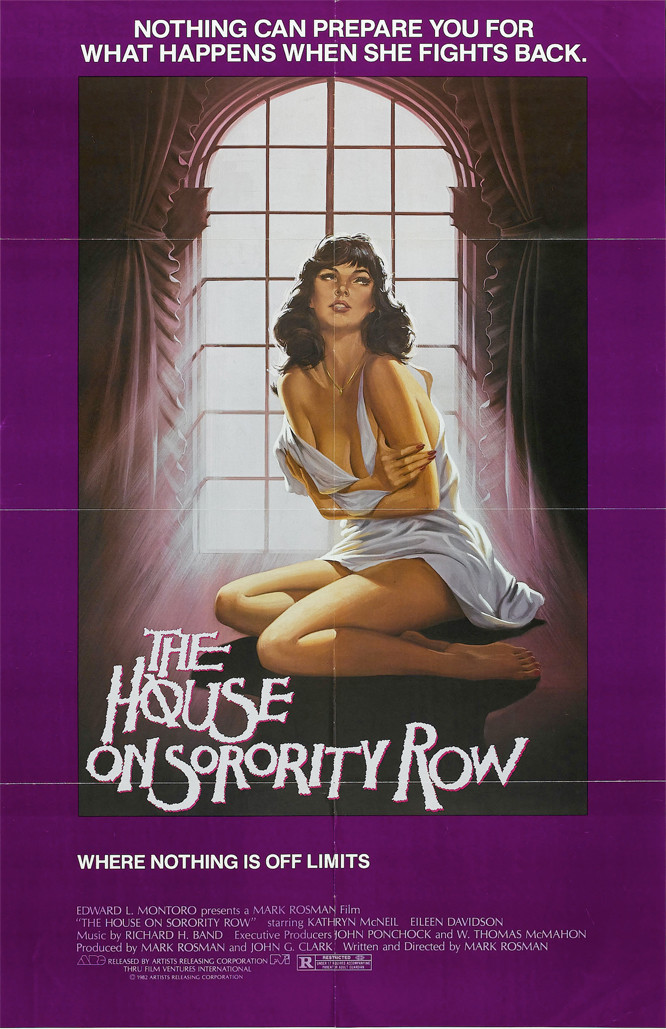
On its opening night, I went to see SORORITY ROW, a flick that is a silly remake of a just-as- silly 1980s slasher. Slashers aren’t my favorite horror flicks, so why this lame remake inspired me, I’ll never know. But inspire it did, and I set myself the task of reviewing a bunch of school-based slashers. Below is the eleventh in this series of reviews.
I fondly remember walking out of SORORITY ROW, the remake of this flick, and saying to myself, “That was really trashy.” Even more fondly, I remember my immediate response: “Yeah, but so was the original.” THE HOUSE ON SORORITY ROW wasn’t exactly one of those 1980s classics screaming for an update. Hell, I’m positive a large percentage of horror fans had never even heard of it; I know I hadn’t before talks of the remake hit the net. Somehow, the perversity of Hollywood redoing such an obscure film drove me to the original, then to the update, and eventually to this entire series of reviews. And I’m glad it did. Because THE HOUSE ON SORORITY ROW is my favorite of all the movies in this series, and a fine place for me to have started with the school based slashers. Yeah, it’s trashy. But it’s trashy fun.
The flick is refreshing right from its establishing shot, for one simple reason: it’s not a big, panning view of a college campus. Instead, writer/director Mark Rosman opens the film with a blue moon. It’s June 19, 1961, and under that moon, a very pregnant young lady is about to have an emergency operation. “She’s the last one,” the doctor says, as he brings the heated knife to her stomach. The last what? And what happened to her baby?
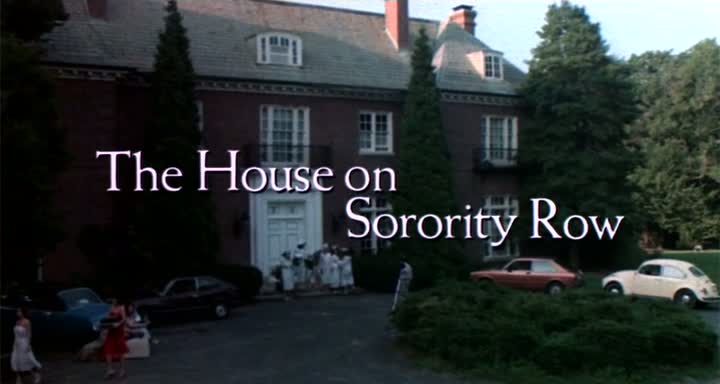
Flash forward about 20 years, and there’s that sweeping shot as a coed runs across the campus. It’s the end of senior year, graduation is upon seven sorority sisters, and they’re ready to have their final college party at their sorority house. Standing in their way is house mother Mrs. Slater, who wants to rid herself and her house of them, the sooner, the better. This causes animosity between her and the girls, most of all Vicki; an especially nasty incident occurs when Slater discovers Vicki and her boyfriend having sex and destroys the girl’s water bed with her bird’s head cane. When Vicki decides to get revenge by staging a prank, the results end up in a character’s accidental murder.
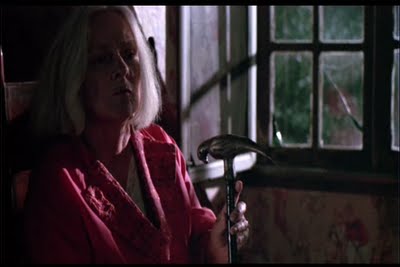
The film sets the stage early on for a personality clash between Slater and Vicki, the domineering elder authority vs. the headstrong youth who threatens to undermine her. The struggle of wills is intensified by the fact that Slater has started to slip into an angry psychosis (beautifully played out when she tears to shreds pictures of her previous sorority classes and throws them in the fire); as she gradually loses her grip on reality, she holds on for dear life to the only thing she has left: her control over the house, and the girls within it. As teens will do, Vicki stubbornly rebels against the house mother, doing what she pleases when she pleases it. Had these two been a little less obstinate, and a little more understanding of the other, they certainly would have avoided violence.
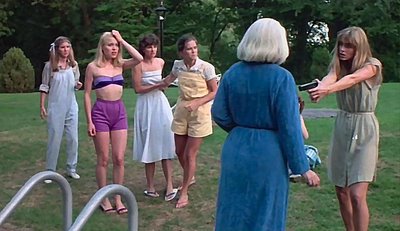
But conflict is the driving force in fiction, and violence comes. The murder acts as the motivating incident for the film, as the girls act quickly to cover themselves by concealing it. I came down hard on the SORORITY ROW remake because once all the girls agree to the cover up, even the good ones are morally reprehensible. The same logic should come to bear in the original as well, but somehow it doesn’t. In the middle of a hectic quarrel about how to react to the murder, they’re flushed into making a hasty decision (a truck arrives with the band for the party); as the night commences they’ll struggle with the decision they made, and grow to regret their choices. I think I forgave them mostly because they’re acting out of fear; in an attempt to cleanse her soul, Karen confesses they were all so scared. This is how teens react in real life, driven to make impulsive choices without weighing out the consequences first.

Had the night not taken a turn for the worse, clearer heads might have prevailed to set things straight. But the party kicks the film into second gear, as a murderer stalks the girls and starts to eliminate them. Rosman provides some great tension, pacing out scenes where the unknowing girls go about the night in ignorance, then punctuating them with a violent kill. The killer himself, dressed in court jester garb and mask, is distinct and creepy.

It’s suggested he may be Slater’s son, the result of the opening scene, and he sure likes putting her cane to violent use; but his identity is never resolved, and this air of mystery makes him even scarier. A plot twist puts Karen’s life in jeopardy near the film’s conclusion, and the ambiguous ending leaves it open as to whether the helpless, ordinary girl will survive the night (thus killing the whole overrated notion of the “final girl” ploy). I was rooting for her right until the end credits started, but I rather suspect she ended grimly after they began to roll.
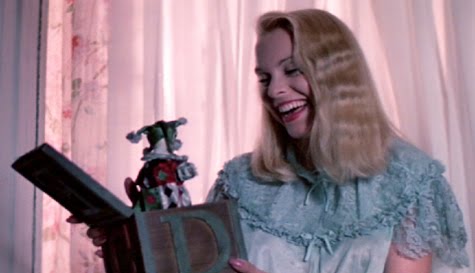
Rosman’s film is much more accomplished than most of the 1980s slashers. His editing keeps things moving at different paces, from the smash cuts that establish the girls’ preparations at the beginning of the film, to the more deliberate timing of the kills. His camera placement keeps things off kilter at times, and goes beyond flat cinematography throughout. Balancing the “hide the body” concept and the slasher’s predatory movements, his plot does a nice job of intertwining the two. And most importantly, his characters are realistic; they’re never over the top or campy, and just look to enjoy their last days together as sisters. An early scene where they’re drinking and getting high shows them for the ordinary teens they are, and I appreciated the movie for that.
One more character of note is the pool. Its foul green waters play a crucial role in the proceedings, and it’s a fine symbol for Slater, a woman who’s let herself go. Submerging things beneath the waters will not submerge the sisters’ problems, as they’ll soon discover. And watch how they react when, at the party, a bunch of frat boys want to dive in.
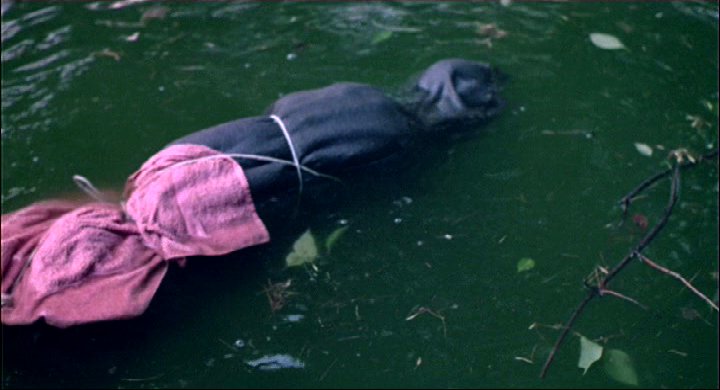
What’s really foul is the lack of extras on this DVD. There’s a sum total of a trailer. I had hoped with the remake that there would be some sort of re-release, but this is all you get. Some of the lesser school slashers got more than this, and this is a bigger crime than the murder the girls are trying to conceal. At least the film’s in wide screen, and doesn’t clip Rosman’s cinematography.
THE HOUSE ON SORORITY ROW has quickly become one of my favorite slashers, and takes the top spot for those based in schools. Its unconventional approach, realistic characters and court jester killer make for a real thriller that is head and shoulders above many of its counterparts, including its remake. Sure, it’s trashy. But it’s smart, trashy, and above all, fun. If only SLAUGHTER HIGH, GRADUATION DAY et al. could claim the same.
-Phil Fasso